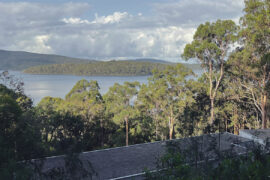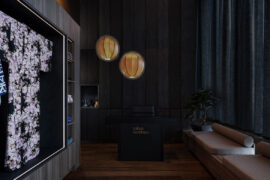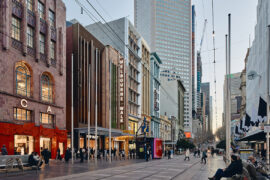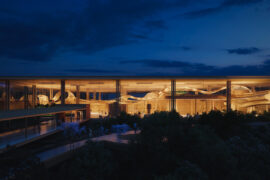The 2025 Australian Architecture Conference has just taken place over two days at the Sydney Opera House and Seymour Centre, with a plethora of international and local speakers.

Nisarga Art Hub by Wallmakers, photo by Syam Sreesylam.
May 6th, 2025
As perhaps the spiritual home of Australian architecture, the Sydney Opera House was a fitting venue for the first day of this year’s national conference. Close to a thousand attendees came together for a series of talks, with Timothy Hill announced as the 2025 Gold Medallist in the final presentation of the first day. Hill has been director of Partners Hill since 2013. Of course, he was also central to the successes of Donovan Hill alongside Brian Donovan and colleagues from 1992 to 2012.
Here is the full list of prize winners announced at the Conference:






“This year’s National Prize winners exemplify a profound commitment to elevating architectural practice through leadership and proactive engagement with our sociocultural contexts,” says Jury Chair, Jane Cassidy FRAIA. “Their legacies stand as a testament to the advancement of the profession through innovation and integrity.”
After Hill received his award, groups peeled off for guided tours of a number of Sydney architectural landmarks – Quay Quarter Tower, Sydney Metro and so on – while the very bravest made it to the Friday evening party at the Chau Chak Wing Museum. Saturday too featured a packed schedule of events, with streams relating to housing, Country, AI and more.
The UTZON Lecture was given by Vinu Daniel, the self-described “vagabond architect” and Principal of Wallmakers in India. Among many awards and moments of recognition, the practice was selected by ArchDaily in its list of 20 Young Practices of 2020, while Daniel was also the youngest Indian architect invited to be a TED Talk speaker.
Related: 8 stories about the housing crisis

Daniel began the lecture by outlining a binary that shaped his architectural education – and one whose rigidity he has come to reject. Faced with a stark choice between traditionalist conservationism and forward-looking modernism, he instead sought out a middle path and found its expression in the form of mud.
Breaking down linear, hierarchical models of practice, Daniel practices a mode of work that involves always being on the move. His place of work has more to do with the site of any given project rather than a fixed office. Starting with a rigorous engagement with place – particularly in terms of material opportunities through local soil types and available labour – Wallmakers makes a virtue of the ethos of ‘making the most of what you’ve got.’
The projects on show are stunning in their formal refinement, using mud bricks and rammed earth techniques to solve functional, programmatic and budgetary problems. The spaces created are utterly unique and appropriate to place. This is architecture in the form of learning and teaching on the go, and something that other parts of the world could certainly take as a precedent.

Following a Welcome to Country, the first day kicked off with Jing Liu, co-founder of New York practice, SO – IL. With project examples from Brooklyn as well as Seoul and even Melbourne (alongside Hassell), Liu’s talk tackled questions of housing density and use of concrete.
Kevin O’Brien was next, and the BVN Principal notably shared stories from projects across regional, remote areas of Australia. Striking a similar note to Vinu Daniel, he spoke about the tensions and overlaps between tradition and modernity in architecture, locating his own work in the rich space of reinterpreting the vernacular using modernist means.
Melbourne’s Mel Bright, Principal and founding director of Studio Bright, was then on hand to explore the conference theme of ‘Architecture in Action.’ Drawing on the studio’s extensive portfolio of beautiful residential design, she spoke of the need to resist the commodification of housing and the precedence of private over public interest. Dieter Leyssen of Brussels-based 51N4E rounded out the first day of talks with a tour of reuse projects in northern Europe, with an enormous concrete submarine bunker project in Saint Nazaire, France being a particularly eye-catching example.
Elsewhere, one of the highlights of Saturday’s proceedings was a talk titled, ‘Towards a Strategic Housing Culture.’ Multiple speakers, including Clare Cousins, Laura Harding and Philip Oldfield, covered examples – positive and, refreshingly, negative – of multi-residential design across the world. Perhaps the summary takeaway was the rejection of the idea that, amidst the housing crisis, we need to choose between good design and building more houses. The two necessities, agreed the speakers, are not in conflict with one another in a zero-sum equation but can instead be achieved in unison.

INDESIGN is on instagram
Follow @indesignlive
A searchable and comprehensive guide for specifying leading products and their suppliers
Keep up to date with the latest and greatest from our industry BFF's!

Rising above the new Sydney Metro Gadigal Station on Pitt Street, Investa’s Parkline Place is redefining the office property aesthetic.

For Aidan Mawhinney, the secret ingredient to Living Edge’s success “comes down to people, product and place.” As the brand celebrates a significant 25-year milestone, it’s that commitment to authentic, sustainable design – and the people behind it all – that continues to anchor its legacy.

London-based design duo Raw Edges have joined forces with Established & Sons and Tongue & Groove to introduce Wall to Wall – a hand-stained, “living collection” that transforms parquet flooring into a canvas of colour, pattern, and possibility.

With projects shortlisted for Habitus House of the Year 2025, Anthony Gill and Jason Gibney join the podcast to discuss the state of housing in Australia today.

Making a splash on the hair spa scene, the latest project from X + O makes a little slice of Japan right at home in suburban Melbourne.
The internet never sleeps! Here's the stuff you might have missed

Buchan weaves heritage and contemporary retail across a 3,600sqm site featuring dual-branded hotels, arcades and revitalised laneways.

Recognised as winners at the INDE.Awards 2025, Enter Projects Asia in collaboration with SOM have received The Influencer award. Their work on Terminal 2 Kempegowda International Airport Interiors redefines the aesthetics of airport design through a monumental expression of biophilia, sustainability and craftsmanship.